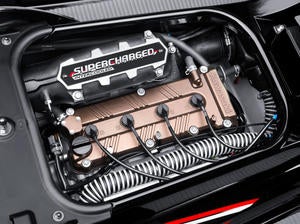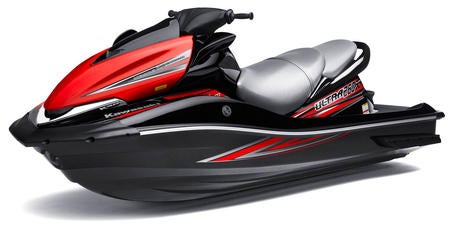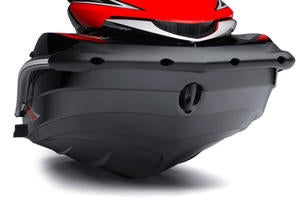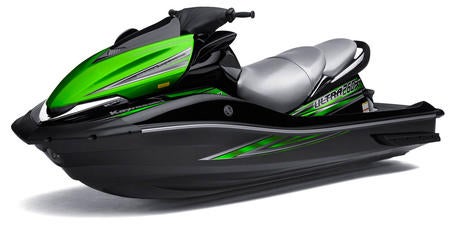2010 Kawasaki Jet Ski Ultra 260X Review
Powerful machine remains big-water favorite
Kawasaki’s Ultra 260X is back in black for 2010, leaving behind the prominent red and lime of last year and replacing them with a predominantly black color scheme. Yes, “sunbeam” red and “candy” lime green still have their place, primarily in strategically placed accents on the hood, but the overall look is just downright bad.
As in, that Kawasaki Ultra 260X is one bad-@$$ machine…
Bad To The Bone
It’s always been that way, no matter what the color scheme.
One part of the reason is the boat’s bad-@$$ engine. A 1,498cc, dual-overhead cam four-cylinder, it boasts the almost required supercharger and intercooler combo to truly crank up the horsepower. Kawasaki argues its Roots-style charger produces a greater amount of boost at a lower rpm, necessary to propel this machine aggressively out of the hole. Last year the company tweaked that engine a little further, replacing the pistons with a new design to raise the compression ratio, adding high-lift cams to increase intake and exhaust, and advancing the ignition. The impeller was also tweaked, and a few potential maintenance issues addressed. Combined, the list of upgrades bumped the horsepower from 250 to 260, and allowed this 1,062-pound boat to reach 30 mph in as little as 1.8 seconds, and easily – easily – surpass the 65 mph mark. Midrange acceleration is especially fun. Cruise along with your friends at 45, then punch the throttle to show them the true meaning of power.

Yes, the Ultra is big, and it feels it in rough water. This is a favorite among offshore racers for good reason — it tracks straight and true, and is little affected by waves and chop. Pick your line, give it the gas, and you’re off into the sunset without a hiccup. The result is a comforting, stable, heavy-feeling presence on big water, whether you need it to get to the mark first, or simply to keep your family safe and secure.
Yes, that same presence makes the boat feel slightly more sluggish in the turns. The Ultra drifts through corners, rather than bites abruptly, with the rider using a comfortable and intuitive inside lean. I think it’s a tradeoff that most buyers, faced with changing water conditions, will find acceptable. Still, those into serious carving should be forewarned and try a test drive.
Beyond Performance
That deep-V hull is mated to a comfortable deck above. The seat is a good mix of soft and firm, providing the cushion required for long hours in the saddle, but providing enough support to enhance performance riding. Handlebars adjust to five separate positions, meaning you can tilt the bars up and stand should you desire to take some of the jolt with your legs. Ridges on the hull deflect spray quite well, and a boarding ladder makes climbing aboard a simpler task in deep water.
Reverse works well, and uses a portside lever with a push-button lock to prevent accidental activation. The information display, however, still is in need of improvement. As noted in previous years, it’s a little small, fuel level is difficult to decipher, and the buttons not that convenient to push. In this era of electronic throttle control and goodies like cruise control, the Ultra also remains relatively straightforward. It lacks gizmos, and doesn’t even feature trim. Fans of the craft perhaps rightly argue that they’re not necessary in a true performance craft.
Kawasaki uses a magnetic key system for security, a device that can also activate a slow-speed mode. Off-throttle steering enhancement is provided by computer, which bumps up rpm in conjunction with the release of the throttle and hard turn of the bars in order to provide directional thrust.
Finally, the Ultra’s “bigness” doesn’t end at the engine and hull. The craft is massive in terms of storage and fuel capacity, with room for 60 gallons-worth of assorted gear, and over 20 gallons of fuel. Yes, at full speed that fuel may quickly be consumed, but cruising speeds are acceptable. And let’s face it; chances are if you’re buying a craft like this, fuel-efficiency is not high on your list of priorities.
Big Change
In case you haven’t guessed it by now, there’s little difference between the 2010 and 2009 model. That color scheme is a rather bold choice, but the only other change for the new year is in the boat’s price. Last year it bumped up a few hundred dollars to $11,999. This year it extends all the way to $12,899. That’s not unreasonable given the competition, but it will likely make buyers think a little longer when making the decision.
Still, the Ultra has an established pedigree. It’s absolutely bad…and that makes it one great muscle machine.
| Kawasaki Jet Ski Ultra 260X Specs | |
| Length | 132.7 inches |
| Beam | 46.9 inches |
| Curb Weight | 1,062.8 lbs |
| Engine | Four-cylinder DOHC EFI; Supercharged/Intercooled |
| Displacement | 1,498 cc |
| Bore and Stroke | 83mm x 69.2mm |
| Compression Ratio | 8.4:1 |
| Rated Horsepower | 260 |
| Fuel Capacity | 20.6 gal. |
| Combined Stowage Capacity | 60 gal. |
| Colors | Ebony/Sunbeam Red, Ebony/Candy Lime Green |
| Price | $12,899 |
Related Reading
2010 Kawasaki Jet Ski STX-15F Review
2010 Kawasaki Jet Ski Lineup Preview
2009 Kawasaki Jet Ski Ultra 260X Review
2009 Kawasaki Jet Ski Ultra 260LX Review
Get PersonalWatercraft.com in your Inbox!
Like PersonalWatercraft.com on Facebook
Comments
Most Popular

Remembering the Sea-Doo XP

2025 Yamaha JetBlaster PRO 2-Up Review

2024 Yamaha GP HO Review

2008 Kawasaki Jet Ski Ultra 250X Review

2024 Kawasaki Jet Ski STX 160X Review















 Your Privacy Choices
Your Privacy Choices